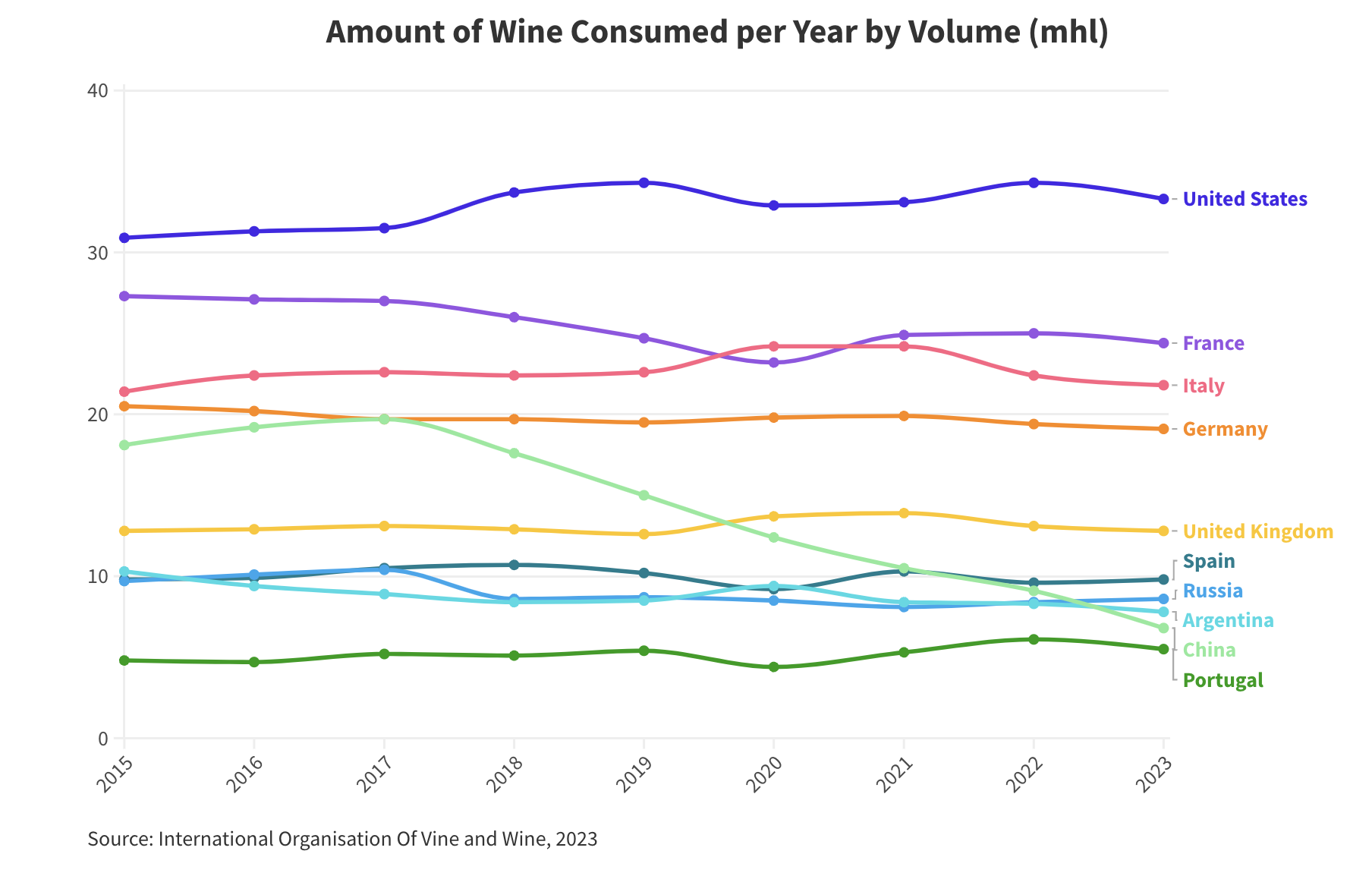What’s new in the Hospitality Industry in China (2025)
In 2025, as global markets continue to interconnect, businesses—especially in industries like hospitality, wine, and luxury services—must adapt to an increasingly diverse, digitally savvy, and culturally complex environment. In this blog we will discuss on how Bright Design Studio works with Chinese and international partners for marketing wines and events promotions.
As a Shanghai-born digital brand agency partnering with wine sellers from globally diverse regions such as Australia, Spain, Italy, South Africa, and more, Bright Design Studio is uniquely positioned to tap into China’s dynamic and fast-growing hospitality market. However, in 2025, succeeding in this landscape requires a deep understanding of cultural diversity, consumer behavior, and the rapidly evolving digital ecosystem in China.
What are the popular imported wines in China right now?
Since 2015, Statista reports show that wine sales in supermarkets and convenience stores are expected to reach $9.7 billion for at-home consumption. In comparison, wine sales in restaurants and bars are predicted to be much higher, at $17.2 billion. Overall, the total revenue from the wine market is projected to be $23 billion by 2025.
While red wine continues to be the dominant choice and remains quite popular among consumers, wine drinkers in China have also begun to demonstrate a growing openness and curiosity toward exploring a variety of other wine styles, including white wines and sparkling wine. This shift in preferences highlights the evolving palate of the Chinese market as consumers seek new and diverse tasting experiences.
Here’s why embracing diversity in marketing and promotion is absolutely critical for businesses in the hospitality industry operating in China:
A Diverse Consumer Market with Varied Tastes
China’s Expanding Wine Market: China’s wine market is evolving rapidly. While traditionally dominated by domestic producers, international wine brands from countries like Australia, Italy, France, and South Africa are becoming increasingly popular. Chinese consumers are showing a growing interest in foreign wines, with a preference for both premium wines and mid-range options.
Regional Preferences: There’s a wide range of tastes and preferences across the country, from the cosmopolitan tastes in cities like Shanghai and Beijing to more regional or culturally specific choices in places like Chengdu or Xi’an. Understanding these local nuances is crucial.
Ethnic Diversity: China is home to a range of ethnic groups, including Han Chinese, Tibetans, Uighurs, and others. Catering to these diverse groups, especially through tailored promotions, ensures your brand resonates with a broader demographic.
How did we support? To effectively market international wines, Bright Design Studio needs to understand not just the overall wine-drinking culture but also local preferences, whether it’s sweet reds popular in certain regions or a demand for premium wine collections in major cities. Marketing should reflect and respect these regional differences following the budgets of partners.
2. The Rise of Affluent Consumers and Wine Tourism
Increased Wealth in Tier-1 and Tier-2 Cities: As China’s middle class grows, there's a significant rise in affluent consumers who are willing to spend on premium experiences, including fine dining, luxury travel, and high-quality wine. Wine tourism is also booming as Chinese consumers travel abroad to explore wine regions like Napa Valley, Tuscany, and the Barossa Valley. This change has resulted in more people drinking high-quality wines from these well-known wine regions.
Wine Enthusiasts and Connoisseurs: There’s a growing market for high-end wines and curated wine-tasting experiences in China, with many consumers seeking out rare and prestigious labels.
Rising Demand for Authentic Experiences: Consumers are looking for authentic, memorable experiences, whether it's a wine tasting in the French countryside or attending a luxury wine dinner at an upscale restaurant in Beijing.
How did we support? Understanding the desires of these affluent consumers and promoting experiences that reflect premium international wines, exclusive wine-tasting events, and even virtual wine tours can help Bright Design Studio better connect with high-end markets in China. A diverse approach, including offering different wine varieties from Australia, Italy, and South Africa, aligns with the growing interest in international, authentic wine experiences.
3. Local Cultural Sensitivities and Consumer Behavior
Respecting Cultural Norms: Cultural understanding is critical for successfully marketing to Chinese consumers. For example, certain colors, symbols, and words have cultural significance—red symbolizes luck, while the number 8 is considered especially lucky. Conversely, numbers like 4 (pronounced "si") are associated with death and should be avoided.
The Importance of Family and Status: In Chinese culture, family and social status play key roles in consumer behavior. Luxury products are often marketed as a way to display wealth and status, and wine brands may need to reflect this in their campaigns.
Online Shopping and WeChat Ecosystem: China’s online landscape is dominated by social media platforms like WeChat, Weibo, and Douyin (the Chinese version of TikTok). Marketing strategies that blend online engagement with offline experiences are essential to reach the modern Chinese consumer. KOLs can be a key factor in promoting such wines and giving out limited time offers allowing clients to immediately make a purchase.
How did we support? In marketing wines and wine-tasting experiences, Bright Design Studio must ensure its campaigns use the right symbols, colors, and messages that resonate culturally. Additionally, creating localized digital campaigns through WeChat or collaborating with Chinese influencers will ensure relevance and engagement with target audiences.
4. Digital Transformation, E-Commerce Dominance & Social Responsibility
Photo by Unsplash.com
Online Shopping Dominance: The hospitality industry in China is increasingly moving toward e-commerce, with platforms like Tmall, JD.com, and Pinduoduo playing an essential role in consumer purchases. This trend is equally prominent in wine sales, where online wine shops and live-streamed shopping events are gaining traction. Currently there are also platforms such as YOOPAY, or Weidian that are more cost effective for smaller businesses and startups.
Social Responsibility and Sustainability
Growing Importance of Sustainability: As Chinese consumers become more aware of environmental issues, there is increasing demand for sustainable products. This includes everything from eco-friendly packaging to wine made through sustainable farming practices.
Green Marketing: Promoting sustainability in wine production, along with supporting eco-friendly initiatives, can help position your brand as socially responsible and in tune with evolving consumer values.
How did we support? Marketing your international wine partners’ sustainable practices can appeal to Chinese consumers, especially those in the younger demographic who are keen on making eco-conscious choices. Localization is key. Incorporating sustainability into your messaging can set your business apart in a competitive market. We offer a variety of innovative solutions, such as an increased focus on digital designs, which minimize the need for extensive printing on physical materials. This approach not only enhances our creative offerings but also promotes a more sustainable and environmentally friendly practice.
6. Adapting to Changing Demographics
Young, Wine-Conscious Generation: China’s Gen Z and Millennials are becoming significant consumers of wine. These younger generations are looking for premium experiences, new tastes, and innovative wine pairings. They tend to be more adventurous and are open to wines from countries like South Africa or Australia, which might have been less popular in the past. Italian wines are still more popular in comparison to these wines.
Health and Wellness Trends: Younger consumers are also increasingly conscious of health and wellness. Promoting low-alcohol or organic wines could appeal to this health-conscious segment.
Low and Non-Alcoholic Wines Are in Demand: As the wellness trend increases in China, low and non-alcoholic wines are becoming popular, especially among millennials and Gen Z. This market is suitable for new ideas, appealing to health-conscious consumers who want wine without the effects of alcohol.
In 2025, businesses in the hospitality and wine sectors must navigate a complex and dynamic market like China. Diversity in marketing and promotion isn’t just a luxury; it’s an imperative. Businesses that embrace local culture, digital innovation, and consumer behavior trends will have a much better chance of success. For Bright Design Studio, understanding China’s cultural diversity, adapting to local digital channels, and integrating global wine offerings with a locally relevant message will be key to building a strong presence in this exciting market.
The hospitality and wine industries in China are rapidly evolving, and businesses that act with sensitivity to both local and global trends will be best positioned to thrive.
Would you like specific strategies or examples for Bright Design Studio’s marketing campaigns in China? Write to us: hello123@brightdesignstudio.net
References:
https://www.china-briefing.com/news/chinas-wine-market-outlook-trends-and-opportunities/



